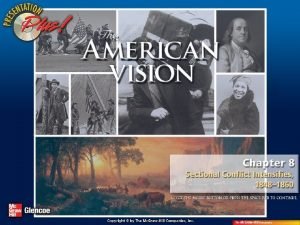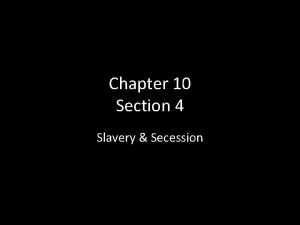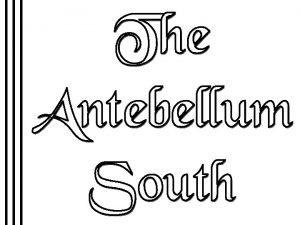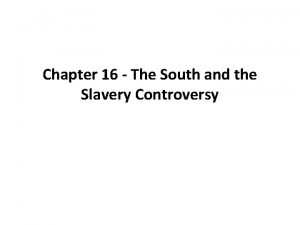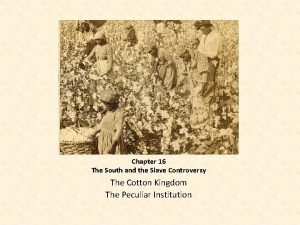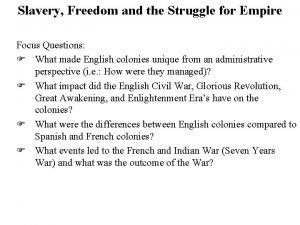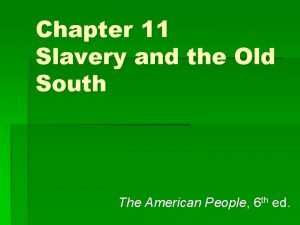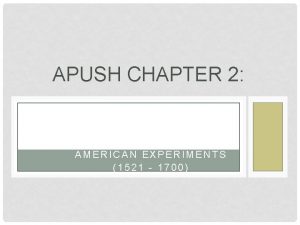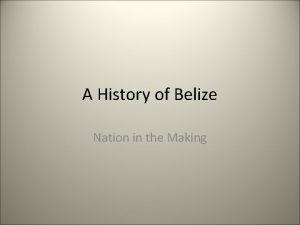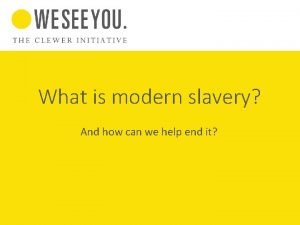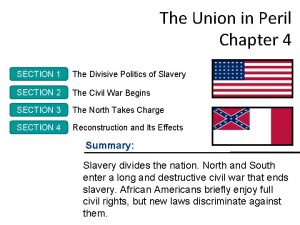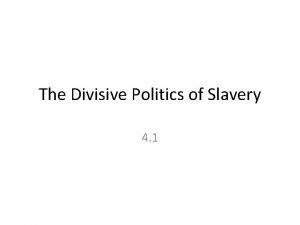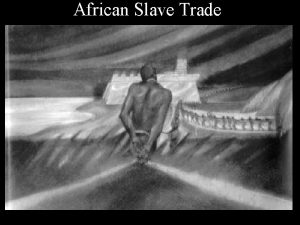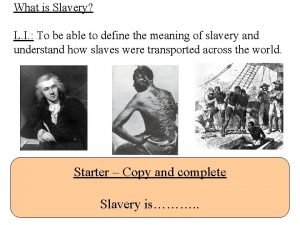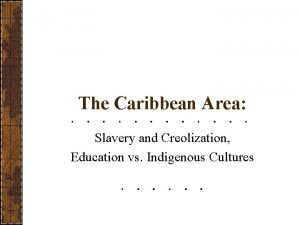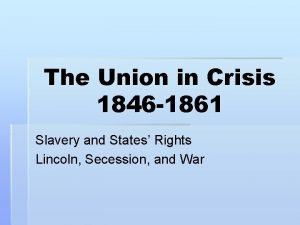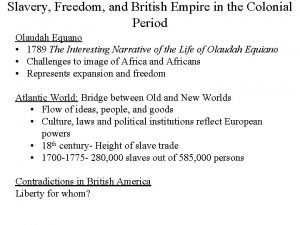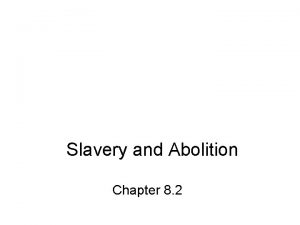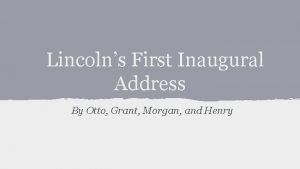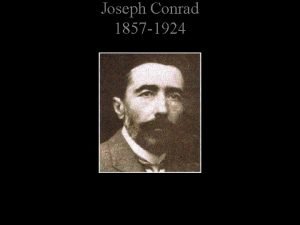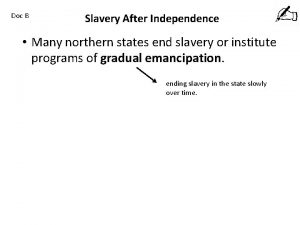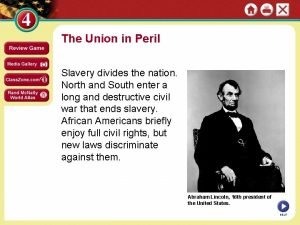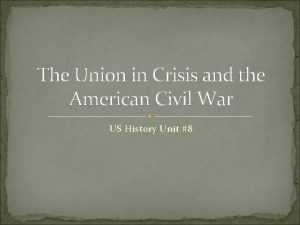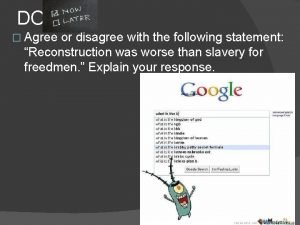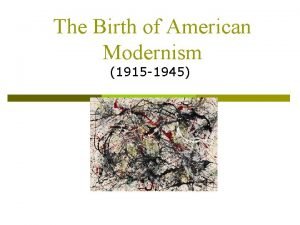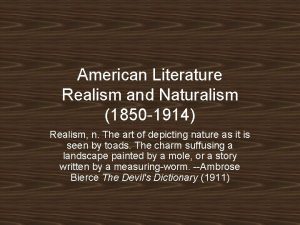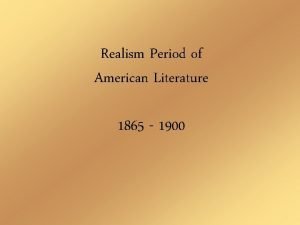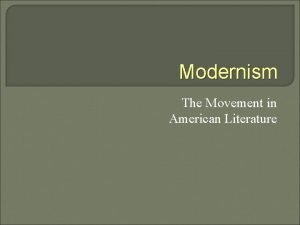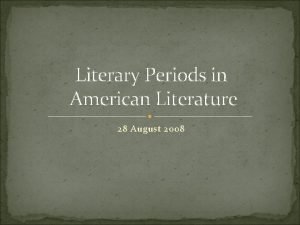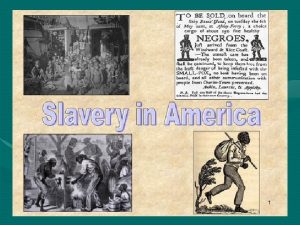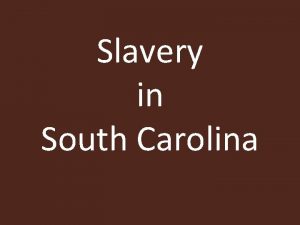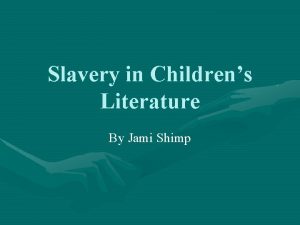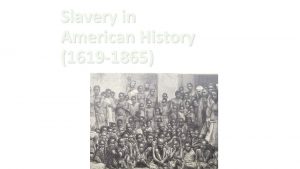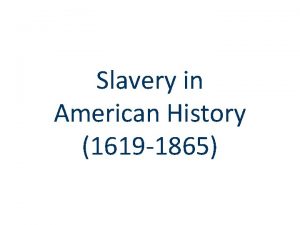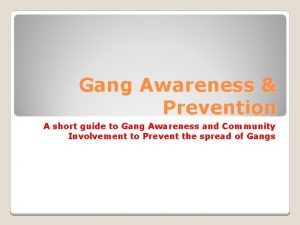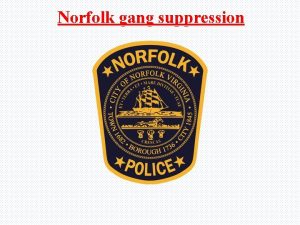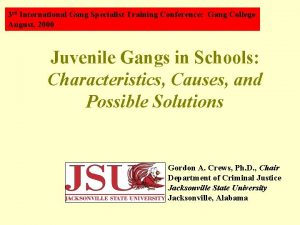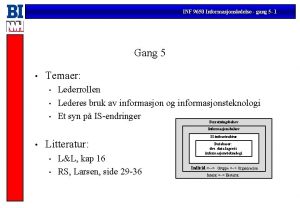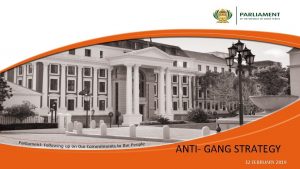Slavery in American Literature Work and Chain Gang
























































- Slides: 56


Slavery in American Literature • Work and “Chain Gang” Songs • “Corn Ditties” and Negro Spirituals • Folk Tales • Slave Narratives • Abolitionist Speeches, Tracts, and Novels

WORK AND “CHAIN GANG” SONGS • During slavery and afterwards, workers were allowed to sing songs during their working time. For example, prisoners used to sing "chain gang" songs when they worked on the road or some construction, or when they needed to coordinate their efforts when hauling heavy loads. . • Some "drivers" also allowed slaves to sing "quiet" songs, if they were not apparently against slaveholders. They were used for expressing personal feeling and for cheering one another. http: //www. youtube. com/watch? v=n. Cg_XS 2 Yrs 4

“I have often sung to drown my sorrow, but seldom to express my happiness. Crying for joy, and singing for joy, were alike uncommon to me while in the jaws of slavery. The singing of a man cast away upon a desolate island might be as appropriately considered as evidence of contentment and happiness, as the singing of a slave; the songs of the one and of the other are prompted by the same emotion. ” - Frederick Douglass, Narrative of the Life of Frederick Douglass

“Corn Ditties” and Spirituals • Rural slaves used to stay after the regular worship services, in churches or in plantation “praise houses”, for singing and dancing. • Because slaveholders did not allow dancing and playing drums, as usual in Africa, they often had meetings at secret places so they could meet one another and share their joys, pains, and hopes. • In rural meetings, thousands of slaves gathered, listened to itinerant preachers, and sang spirituals for hours. In the late 1700 s, they sang the precursors of spirituals, which were called “corn ditties. ”

Lyrics of Negro Spirituals • While work songs dealt only with their daily life, spirituals borrowed a lot of imagery from the Bible. Some were inspired by the New Testament message of Jesus Christ - “You can be saved” – while others drew from the Old Testament stories of the Jews’ escape from slavery in Egypt. • Many slaves tried to run to a “free country” that they called “my home” or “Sweet Canaan, the Promised Land. ” This country was on the Northern side of the Ohio River, which they called the “Jordan. ”

NEGRO SPIRITUALS AND THE UNDERGROUND RAILROAD Some negro spirituals, such as “Wade in the Water, ” “The Gospel Train, ” and “Swing Low, Sweet Chariot, ” directly refer to the Underground Railroad, an organization that helped slaves run to freedom in the North. A fugitive could attempt escape in several ways: – They could walk at night, using hand lights and moonlight. – They could walk (or “wade”) in water so that dogs could not smell their tracks. – They could jump into a chariot, where they could hide and ride away. – They could temporarily stop at “stations” where they

Call-and-Response Chant SWING LOW SWEET CHARIOT Lead: Swing low, sweet chariot Chorus: Coming for to carry me home Lead: If you get there before I do Chorus: Coming for to carry me home Lead: Tell all my friends, I’m coming too Chorus: Coming for to carry me home

Follow the Drinking Gourd • Closely associated with the Underground Railroad, the song “Follow the Drinking Gourd” supposedly encodes escape instructions and a map. • The "drinking gourd" refers to the hollowed out gourd used by slaves as a water dipper. In this song, it serves as a code name for the Big Dipper. • The song's directions enabled fleeing slaves to make their way north from Alabama to the Ohio River and freedom; instructions are included in the song to follow the points of the drinking gourd (the Big Dipper) to the brightest star, which is the North Star.

Thoughts on Slavery by Early Presidents and Founding Fathers “Not only do I pray for it, on the score of human dignity, but I can clearly foresee that nothing but the rooting out of slavery can perpetuate the existence of our union, by consolidating it in a common bond of principle. ” - GEORGE WASHINGTON, attributed, John Bernard's Retrospections of America

“That the fall of slavery is predetermined in the counsels of Omnipotence I cannot doubt; it is a part of the great moral improvement in the condition of man, attested by all the records of history. But the conflict will be terrible, and the progress of improvement perhaps retrograde before its final progress to consummation. ” - JOHN QUINCY ADAMS, journal, Dec. 11, 1838

“I hate (this zeal for slavery) because it deprives our republican example of its just influence in the world, enables the enemies of free institutions with plausibility to taunt us as hypocrites, causes the real friends of freedom to doubt our sincerity, and especially because it forces so many good men among ourselves into an open war with the very fundamental principles of civil liberty, criticizing the Declaration of Independence, and insisting that there is no right principle of action but self-interest. ” - ABRAHAM LINCOLN, speech, Oct. 16, 1854

“If slavery is not wrong, nothing is wrong. ” - ABRAHAM LINCOLN, letter to A. G. Hodges, Apr. 4, 1864

Ben Franklin’s Petition to Congress • In 1787, Franklin began to serve as President of the Pennsylvania Society for Promoting the Abolition of Slavery. • In 1789 he wrote and published several essays supporting abolition. • In 1790, in his last public act before his death, he petitioned Congress to end slavery, calling upon them to “devise means for removing the Inconsistency from the Character of the American People, ” and to “promote mercy and justice toward this distressed Race. ”

Slave Narratives of slavery recounted the personal experiences of antebellum African Americans who had escaped from slavery and found their way to safety in the North.

Influences An essential part of the anti-slavery movement, these narratives, in an effort to appeal to their (often white) audiences, drew on: – – – Biblical allusion and imagery Rhetoric of abolitionism Traditions of the captivity narrative Spiritual autobiographies and devotional books New England sermonizing traditions Some of these narratives bore a "frame" or preface attesting to their authenticity and to the sufferings described within.

Some recalled being captured and held in Slave Sheds …

Others described their miserable transport on Slave Ships…

Some described Slave Auctions …

Others focused on Plantation Life

Some recalled Beatings …

Others told of their Escapes …

In “The Representation of Slavery and Afro. American Literary Realism, ” Williams Andrews states: "The ante-bellum slave narrative was the product of fugitive bondmen who rejected the authority of their masters and their socialization as slaves and broke away, often violently, from slavery. . Through an emphasis on slavery as deprivation-buttressed by extensive evidence of a lack of adequate food, clothing, and shelter; the denial of basic familial rights; the enforced ignorance of most religions or moral precepts; and so on--the ante-bellum narrative pictures the South's ‘peculiar institution’ as a wholesale assault on everything precious to humankind” (79).

Frederick Douglass (18181895) • Born Frederick Augustus Washington Bailey on Maryland’s Eastern Shore • Son of a slave woman and her white master. • Abolitionist, writer, and orator • Wrote Narrative of the Life of Frederick Douglass, an American Slave (1845), regarded as one of the finest examples of the slave narrative tradition and as a classic of American autobiography

Harriet Jacobs: Incidents in the Life of a Slave Girl This classic memoir of slave life, written by a highly-literate North Carolina slave, was first published at the beginning of the Civil War when Jacobs had escaped to the North and begun campaigning for abolition. Her narrative focused especially clearly on the ways that slavery degraded women through sexual abuse and the separation of mothers from their children.















Purposes of the Slave Narrative • Aroused the sympathy of readers in order to promote humanitarianism and abolition • Emphasized traditional Christian religious ideas • Showed acceptance of the ideals of the dominant white society • Emphasized the cruelty of individual slave owners

Frequently Repeated Motifs • Physical, emotional, and sexual abuses of slavery • White owners' hypocrisy and inconstancy • Quest for literacy • Quest for freedom • Loss of significant family member(s) and the destruction of family ties

Reasons for Popularity • Lurid scenes of horror and violence that served an appetite for sensationalism • Religious influence and instructional content • Interesting descriptions of life in the South • Propaganda weapons during abolition and Civil War

Frequent Patterns for Slave Narratives • Loss of innocence/development of an awareness of what it means to be a slave • Realization of alternatives to bondage/formulation of a resolve to be free • Struggle to overcome evil/escape • Freedom obtained/arrival at the New Jerusalem

Parallels with the Captivity Narrative (which usually involved a White woman and a Native American) Typically, the narrator of the slave narrative … • Is abruptly brought from state of protected innocence to confrontation with the evil of slavery and captivity • Suffers from forced existence in an alien society • Is unable to submit or effectively to resist • Balances yearning for freedom against the perils of escape • Sees his or her condition as a symbol of the suffering condition of all the lowly and oppressed • Grows in moral and spiritual strength as a result of suffering and torment

Speeches by White abolitionists and books by White authors also played a big role in helping to bring about change …

“Whenever I hear anyone arguing for slavery, I feel a strong impulse to see it tried on him personally. ” - ABRAHAM LINCOLN, speech, Mar. 17, 1865

William Lloyd Garrison, Abolitionist (1854) “I am a believer in that portion of the Declaration of American Independence in which it is set forth, as among self-evident truths, "that all men are created equal; that they are endowed by their Creator with certain inalienable rights; that among these are life, liberty, and the pursuit of happiness. " Hence, I am an abolitionist. Hence, I cannot but regard oppression in every form – and most of all, that which turns a man into a thing – with indignation and abhorrence. Not to cherish these feelings would be recreancy to principle. ” rec·re·ant (r k r - nt). adj. 1. Unfaithful or disloyal to a belief, duty, or cause. 2. Craven or cowardly. n. 1. A faithless or disloyal person. 2. A coward. .

Garrison further states: “Convince me that one man may rightfully make another man his slave, and I will no longer subscribe to the Declaration of Independence. Convince me that liberty is not the inalienable birthright of every human being, of whatever complexion or clime, and I will give that instrument to the consuming fire. I do not know how to espouse freedom and slavery together. ”

Some Thoughts from Mark Twain’s Huckleberry Finn … Huck says of Jem: “When I waked up just at daybreak he was sitting there with his head down betwixt his knees, moaning and mourning to himself. I didn't take notice nor let on. I knowed what it was about. He was thinking about his wife and his children, away up yonder, and he was low and homesick; because he hadn't ever been away from home before in his life; and I do believe he cared just as much for his people as white folks does for their'n. It

Uncle Tom’s Cabin (1852), by Harriet Beech Stowe • Changed forever how Americans viewed slavery • Demanded that the United States deliver on the promise of freedom and equality • Galvanized the abolition movement • Contributed to the outbreak of the Civil War • Resonated with an international audience as a protest novel and literary work • Sold 10, 000 copies in the United States in its first week; 300, 000 in the first year; and in Great Britain, 1. 5 million copies in one year

"I would write something that would make this whole nation feel what an accursed thing slavery is. ” - Harriet Beecher Stowe

Author's Preface from Uncle Tom's Cabin "The object of these sketches is to awaken sympathy and feeling for the African race, as they exist among us; to show their wrongs and sorrows, under a system so necessarily cruel and unjust as to defeat and do away the good effects of all that can be attempted for them, by their best friends, under it. ” --Harriet Beecher Stowe

The Novel’s Impact When Harriet Beecher Stowe met President Abraham Lincoln in 1862, he is said to have exclaimed, "So you are the little woman who wrote the book that started this great war!"

Emancipation Proclamation • Lincoln’s Emancipation Proclamation, effective January 1, 1863, declared all slaves in the rebellious states “thenceforward, and forever free. ” As he signed the document, Lincoln remarked that “I never, in my life, felt more certain that I was doing right, than I do in signing this paper. ”

Booker T. Washington: Up From Slavery The future African-American leader Booker T. Washington was about seven years old when the Emancipation Proclamation was read on his plantation. As he recalled in his 1901 memoir Up From Slavery: “As the great day drew nearer, there was more singing in the slave quarters than usual. It was bolder, had more ring, and lasted later into the night. Most of the verses of the plantation songs had some reference to freedom. . Some man who seemed to be a stranger (a U. S. officer, I presume) made a little speech and then read a rather long paper — the Emancipation Proclamation, I think. After the reading we were told that we were all free, and could go when and where we pleased. My mother, who was standing by my side, leaned over and kissed her children, while tears of joy ran down her cheeks. She explained to us what it all meant, that this was the day for which she had been so long praying, but fearing that she would never live

“Reconstruction” Amendments As a condition of regaining their congressional representation, the seceding states were obliged to ratify the Thirteenth, Fourteenth, and Fifteenth Amendments to the U. S. Constitution. These “Reconstruction Amendments” abolished slavery, guaranteed equal protection of the law — including by the states — to all citizens, and barred voting discrimination on the basis of “race, color, or previous condition of servitude. ” The years following the Civil War thus established the legal basis for guaranteeing African Americans the civil rights accorded other Americans. Shamefully, the plain meaning of these laws would be ignored for nearly another century, as the politics of sectional compromise again would trump justice for African Americans.
 Sequence of food chain
Sequence of food chain Lesson 1 slavery and western expansion
Lesson 1 slavery and western expansion Chapter 10 section 4 slavery and secession
Chapter 10 section 4 slavery and secession Key and peele slavery
Key and peele slavery Chapter 16 the south and the slavery controversy
Chapter 16 the south and the slavery controversy Chapter 16 the south and the slavery controversy
Chapter 16 the south and the slavery controversy Slavery freedom and the struggle for empire
Slavery freedom and the struggle for empire What is coloniazation
What is coloniazation Chapter 11 cotton slavery and the old south
Chapter 11 cotton slavery and the old south Chapter 11 cotton slavery and the old south
Chapter 11 cotton slavery and the old south Value chain and supply chain difference
Value chain and supply chain difference Open kinetic chain exercises
Open kinetic chain exercises Toward civil war lesson 3 secession and war
Toward civil war lesson 3 secession and war Aspects of negro life: from slavery through reconstruction
Aspects of negro life: from slavery through reconstruction Chapter 2 american experiments summary
Chapter 2 american experiments summary Slavery in belize
Slavery in belize Comparing colonial regions
Comparing colonial regions Charter colonies definition
Charter colonies definition Total fertility rate formula
Total fertility rate formula Rooney family slavery
Rooney family slavery Chapter 4 section 1 the divisive politics of slavery
Chapter 4 section 1 the divisive politics of slavery The divisive politics of slavery
The divisive politics of slavery Slavery grievance (modified) answer key chart
Slavery grievance (modified) answer key chart Slave iron muzzle
Slave iron muzzle Slavery divides the nation answer key
Slavery divides the nation answer key Slavery documentary
Slavery documentary Triangular trade routes apush
Triangular trade routes apush Slavery debates
Slavery debates Fourierism
Fourierism Slavery
Slavery Abolitionists speak out main idea
Abolitionists speak out main idea Election of 1860 pie chart
Election of 1860 pie chart Heart of darkness quotes racism
Heart of darkness quotes racism Missouri compromise
Missouri compromise Slavery divides the nation
Slavery divides the nation How did bleeding kansas embody the slavery controversy
How did bleeding kansas embody the slavery controversy Worse than slavery cartoon
Worse than slavery cartoon Slavery divides the nation
Slavery divides the nation American modernist novels
American modernist novels Realism and naturalism in literature
Realism and naturalism in literature American literature romanticism
American literature romanticism Regionalism definition literature
Regionalism definition literature Encounters and foundations to 1800
Encounters and foundations to 1800 Romanticism vs realism vs naturalism
Romanticism vs realism vs naturalism Section 4 review physical science
Section 4 review physical science Graffiti signs and symbols
Graffiti signs and symbols Mediator wzorzec
Mediator wzorzec Hari and gang
Hari and gang Characteristics of realism art
Characteristics of realism art Realism in american literature
Realism in american literature American literature colonial period
American literature colonial period Naturalism in literature
Naturalism in literature Modernism in literature
Modernism in literature Literary periods and their characteristics
Literary periods and their characteristics Introduction to puritan literature
Introduction to puritan literature Native american literature definition
Native american literature definition Periods of american literature
Periods of american literature

